An Improved Acid Fracturing Design through RoqSCAN Technology: A Case Study from Daniudi Gas Field in Ordos Basin, China
Abstract
:1. Introduction
2. Target Well
2.1. Physical Parameter
2.2. Comprehensive Evaluation
3. Research Method
4. Results and Discussion
4.1. Fine Reservoir Evaluation
4.1.1. Experimental Setup
4.1.2. Element and Mineral
4.1.3. Rock Mechanical Parameters
4.2. Acid Fracturing Design
4.2.1. Fine Reservoir Modeling
4.2.2. Comparative Analysis
4.2.3. Fracturing Design
5. Conclusions
- (1)
- The RoqSCAN technology had good applicability and could significantly improve modeling accuracy. Carbonate rock was the main mineral, taking up 70%, followed by quartz minerals, accounting for about 10%, and clay minerals, accounting for about 9%. The elastic modulus and Poisson’s ratio were distributed between 60–100 GPa and 0.18–0.31, respectively. The brittleness index of the target interval was slightly higher, ranging from 38.5 to 99.6, which was conducive to fracturing reconstruction.
- (2)
- Compared with the conventional modeling, the model with some parameters obtained by the RoqSCAN tool in this paper had higher accuracy. These parameters, including minerals, rock mechanics, and the maximum and minimum horizontal principal stresses, were used for three-dimensional geological modeling, which was more accurate than the traditional data derived from logging and geological interpretation data. The longitudinal and planar distributions of porosity and stress indicated that fine reservoir modeling was more accurate. Gelled acid had a favorable performance. Numerical simulation results showed that the acid-etched fracture was 150 m long, with an average acid-etched conductivity of 20 D.cm.
Author Contributions
Funding
Data Availability Statement
Conflicts of Interest
References
- EIA. Annual Energy Outlook 2018; U.S. Energy Information Administration: Washington, DC, USA, 2022.
- Zhang, L.; Zhou, F.; Mou, J.; Xu, G.; Zhang, S.; Li, Z. A new method to improve long-term fracture conductivity in acid fracturing under high closure stress. J. Petrol. Sci. Eng. 2018, 171, 760–770. [Google Scholar] [CrossRef]
- Zhang, L.; Zhou, F.; Zhang, S.; Li, Z.; Wang, J.; Wang, Y. Evaluation of permeability damage caused by drilling and fracturing fluids in tight low permeability sandstone reservoirs. J. Petrol. Sci. Eng. 2019, 175, 1122–1135. [Google Scholar]
- Zhang, L.; Zhou, F.; Mou, J.; Pournik, M.; Tao, S.; Wang, D.; Wang, Y. Large-scale true tri-axial fracturing experimental investigation on diversion behavior of fiber using 3D printing model of rock formation. J. Petrol. Sci. Eng. 2019, 181, 106171. [Google Scholar] [CrossRef]
- Zhang, L.; Zhou, F.; Mou, J.; Feng, W.; Li, Z.; Zhang, S. An integrated experimental method to investigate tool-less temporary-plugging multistage acid fracturing of horizontal well by using self-degradable diverters. SPE J. 2020, 25, 1204–1219. [Google Scholar] [CrossRef]
- Jiang, T.; Bian, X.; Sun, C.; Zhang, F.; Lin, L.; Wei, J.; Zhong, G. Key Technologies in Geology-Engineering Integration Volumetric Fracturing for Deep Shale Gas Wells. Earth Sci. 2023, 48, 1–13. [Google Scholar]
- Zou, C.N.; Zhao, Q.; Cong, L.Z.; Wang, H.; Shi, Z.; Wu, J.; Pan, S. Development Progress, Potential and Prospect of Shale Gas in China. Nat. Gas Ind. 2021, 41, 1–14. [Google Scholar]
- Wu, Q.; Liang, X.; Xian, C.; Li, Y. Geological-engineering integration and efficient development of marine shale gas in southern China. China Pet. Explor. 2015, 20, 1–23. [Google Scholar]
- Li, S.G.; Xu, T.J.; Lü, Q.; Fan, H.; Zhou, X. Seismic Prediction Technology with Double “Desert” Parameters for Deep Shale Gas. Nat. Gas Ind. 2019, 39, 113–117. [Google Scholar]
- Liao, D.L.; Lu, B.P.; Chen, Y.J. An Evaluation Method of Geological Sweet Spots of Shale Gas Reservoir: A Case Study of the Jiaoshiba Gas Field, Sichuan Basin. Acta Pet. Sin. 2019, 40, 144–151. [Google Scholar]
- Nie, H.K.; He, Z.L.; Liu, G.X.; Zhang, G.R.; Lu, Z.Y.; Li, D.H.; Sun, C.X. Status and Direction of Shale Gas Exploration and Development in China. J. China Univ. Min. Technol. 2020, 49, 13–35. [Google Scholar]
- Jiang, T.X.; Bian, X.B.; Yuan, K.; Zhou, L. A New Method in Staged Fracturing Design Optimization for Shale Gas Horizontal Wells. Pet. Drill. Tech. 2014, 42, 1–6. [Google Scholar]
- Liang, X.; Wang, G.; Xu, Z.; Zhang, J.; Chen, Z.; Xian, C.; Lu, H.; Liu, C.; Zhao, C.; Xiong, S. Comprehensive evaluation technology for the dessert of marine complex mountain shale gas reservoirs in southern China—Taking Zhaotong National Shale Gas Demonstration Zone as an example. Nat. Gas Ind. 2016, 36, 33–42. [Google Scholar]
- Yang, Z.; Tang, Z.; Chen, X.; Guo, X.; Li, C.; Wu, Y.; Huang, D.; Jiang, T.; Xiang, W.L.; Wu, Y.; et al. “Source exploration”: Main types of tight oil and progress in geological engineering integration. China Pet. Explor. 2020, 25, 73–83. [Google Scholar]
- Wang, H.; Liu, Y.; Zhang, X.; Guo, W.; Yu, R.; Sun, Y.; Liang, P.; Kang, L. Geology-Engineering Intergration Shale Gas Sweet Spot Evaluation Based on Analytic Hierarchy Process: Application to Zhaotong Shale Gas Demonstration District, Taiyang Shale Gas Field, Haiba Area, X Well Region. Earth Sci. 2023, 48, 92–109. [Google Scholar]
- Jiang, Z.; Liang, Z.; Shen, Y.; Tang, X.; Wu, W.; Li, Z.; Xue, Z. Coupling Key Factors of Shale Gas Sweet Spot and Research Direction of Geology-Engineering Integration in Southern Sichuan. Earth Sci. 2023, 48, 110–129. [Google Scholar]
- Chen, M.; Tang, C.; Ou, C.; Wang, C.; Liang, B. Application effect analysis of RoqSCAN technology in shale gas mud cutting in southern Sichuan. Well Logging Eng. 2020, 31, 21–28. [Google Scholar]
- Ashton, T.; Eagleridge Energy LLC; Ly, C.V.; Spence, G. Robertson—A CGG Company; Oliver, G. SPE 168806 /URTeC 1581626 Application of Real-Time Well-Site Tools for Enhanced Geosteering, Reservoirand Completions Characterization. In SPE/AAPG/SEG Unconventional Resources Technology Conference; OnePetro: Richardson, TX, USA, 2013. [Google Scholar]
- Wang, T.; Yang, Y.; Peng, Y.; Zhao, J.; Qi, T.; Zeng, J.; Hou, P. Simulation and evaluation for acid fracturing of carbonate reservoirs based on embedded discrete fracture model. Nat. Gas Ind. B 2021, 8, 637–649. [Google Scholar] [CrossRef]
- Zhang, L.; Mou, J.; Cheng, X.; Zhang, S. Evaluation of ceramsite loss control agent in acid fracturing of naturally fractured carbonate reservoir. Nat. Gas Ind. B 2021, 8, 302–308. [Google Scholar] [CrossRef]
- Johnson, C.; Pownceby, M.I.; Wilson, N.C. The application of automated electron beam mapping techniques to the characterisation of low grade, fine-grained mineralisation; potential problems and recommendations. Miner. Eng. 2015, 79, 68–83. [Google Scholar] [CrossRef]
- Ashton, T.; Ly, C.V.; Spence, G.; Guy, O. Portable Technology Puts Real-time Automated Mineralogy on the Well Site. In Proceedings of the SPE Unconventional Resources Conference and Exhibition-Asia Pacific, Brisbane, Australia, 11–13 November 2013. [Google Scholar] [CrossRef]
- Oliver, G.M.; Ly, C.V.; Spence, G.; Rael, H. A New Approach to Measuring Rock Properties Data from Cores & Cuttings for Reservoir & Completions Characterization: An Example from the Bakken Formation. In Proceedings of the SPE Unconventional Resources Conference and Exhibition-Asia Pacific, Brisbane, Australia, 11–13 November 2013. [Google Scholar] [CrossRef]
- Ly, C.V.; Oliver, G.M.; Spence, G.; Centurion, S.; Jackson, C.E.; Hearn, F.P.; Palomarez, V. Cross Correlation of Logging Data with SEM-Based Mineralogical and Textural Well Data: A New Tool for Optimized Completion Design. In Proceedings of the SPE Russian Oil and Gas Exploration & Production Technical Conference and Exhibition, Moscow, Russia, 14–16 October 2014. [Google Scholar] [CrossRef]
- Chatellier, J.-Y.; Tristan, E. New Approach to Reveal Compartmentalization in Montney Horizontal Wells for Completion Design Optimization. In Proceedings of the SPE/AAPG/SEG Unconventional Resources Technology Conference, Houston, TX, USA, 26–28 July 2021. [Google Scholar] [CrossRef]
- Peake, N.; Castillo, G.; Voisey, S.; Chesser, K.; Van de Coevering, N.; Bouziat, A.; Oliver, G.; Ly, C.V.; Mayer, R.; Kuo, L. Unconventional Reservoirs: Integrating Surface Seismic, Microseismic, Mineralogy and Rock Properties in the Haynesville Shale. In Proceedings of the SPE/AAPG/SEG Unconventional Resources Technology Conference, Denver, CO, USA, 25–27 August 2014. [Google Scholar] [CrossRef]
- Peng, X.; Deng, H.; He, J.; Lei, T.; Zhang, Y.; Hu, X. Characteristics and genesis of fractures in the Middle Ordovician Majiagou Formation of the Daniudi Gas Field in the Ordos Basin. Pet. Exp. Geol. 2022, 44, 41–50+93. [Google Scholar]

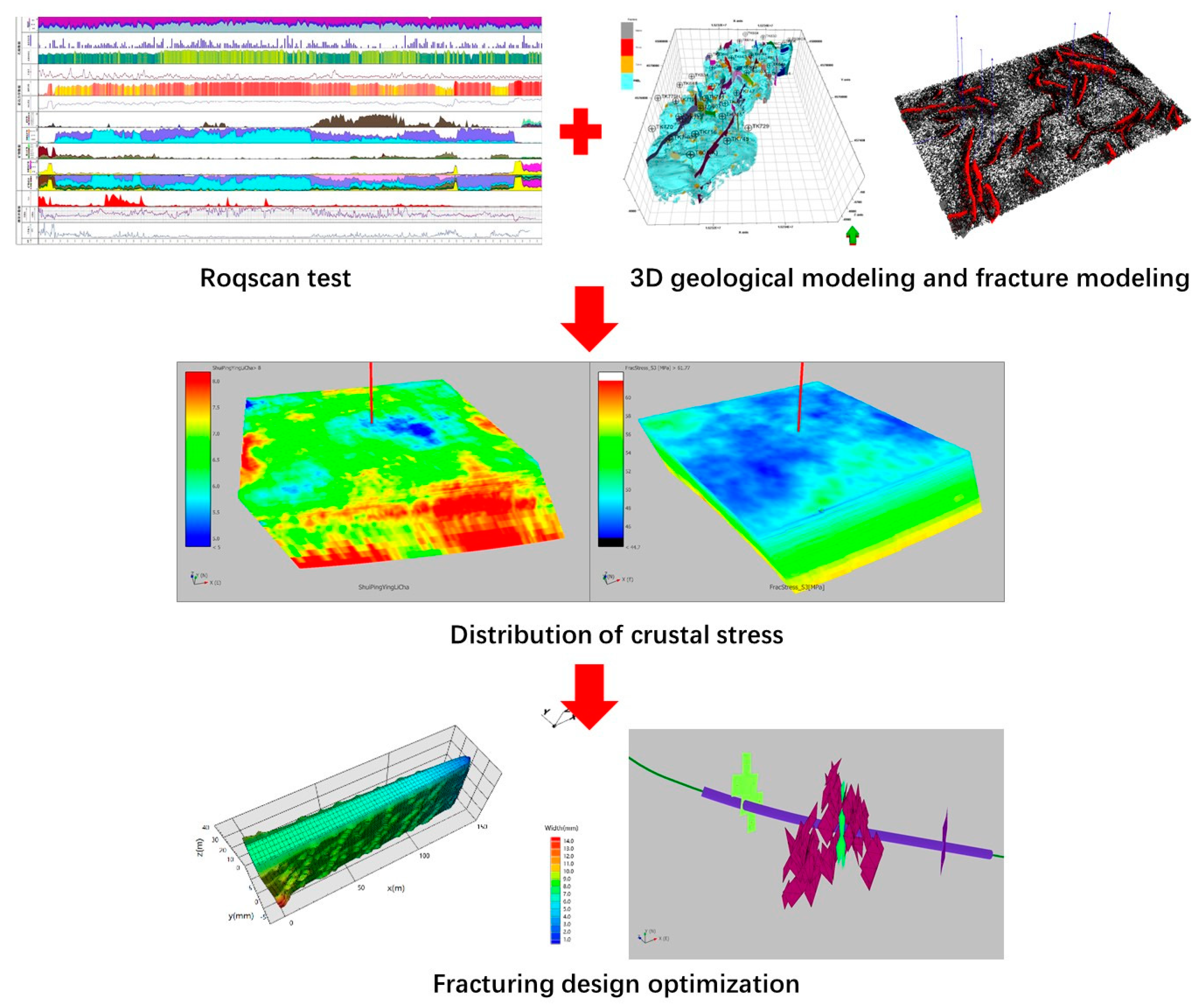
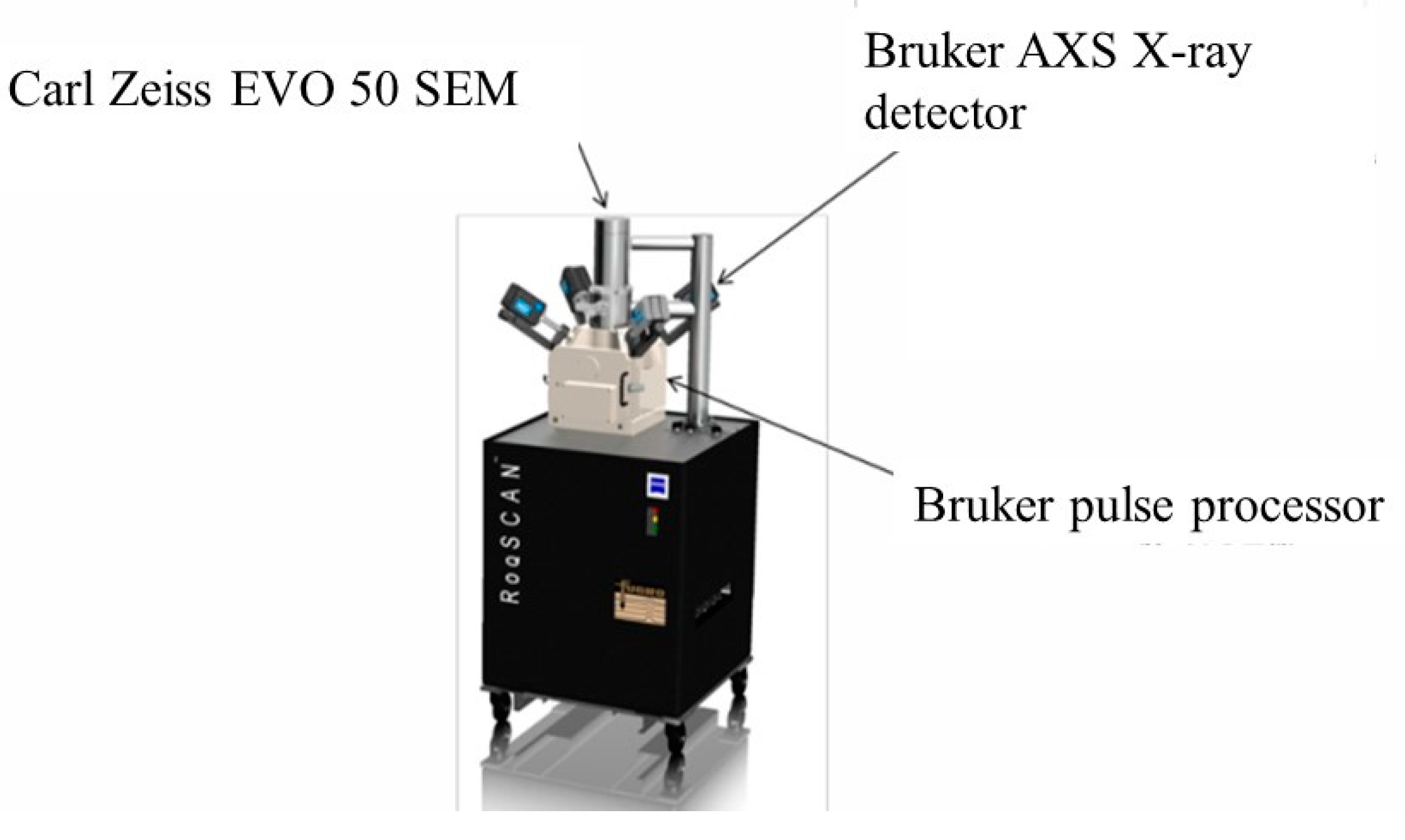




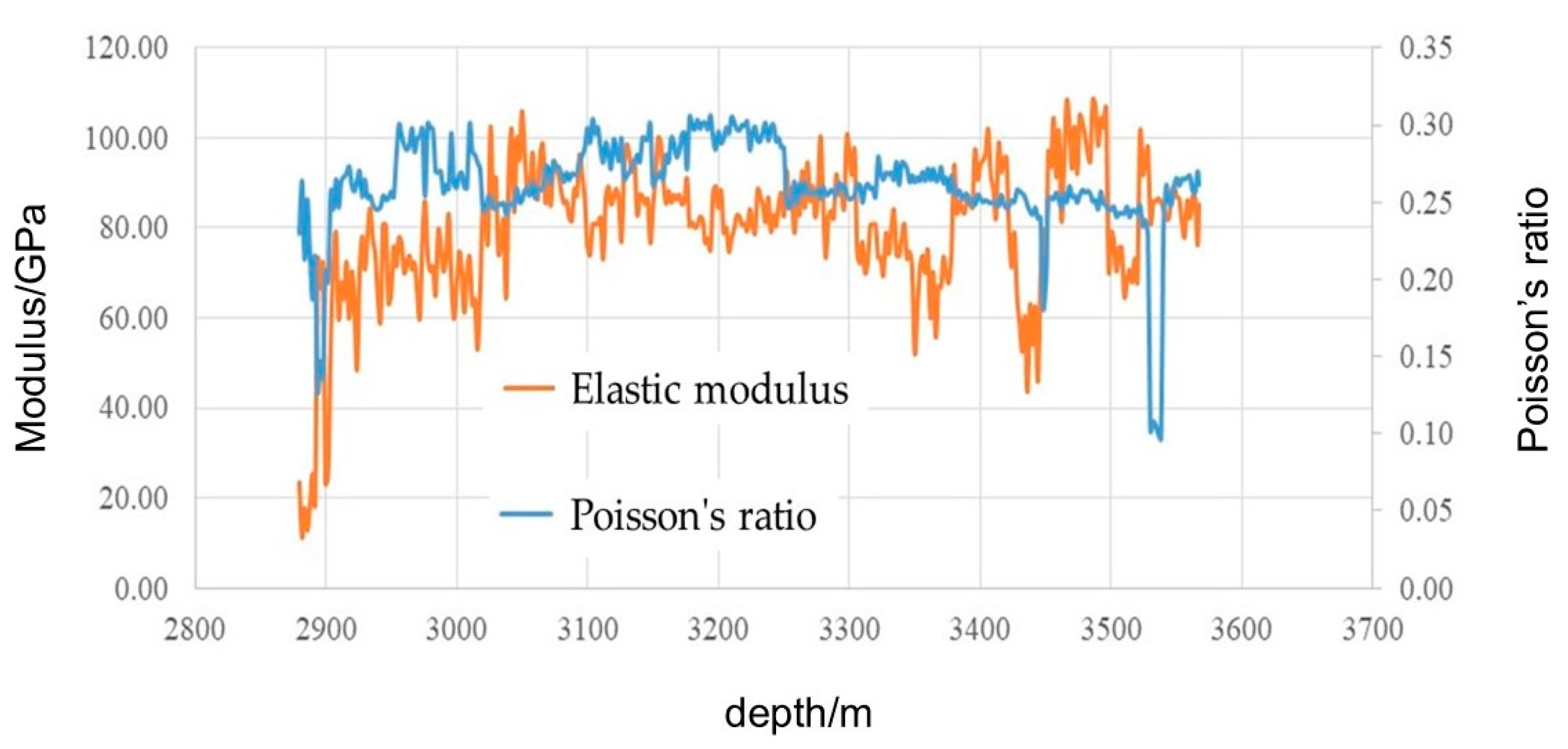

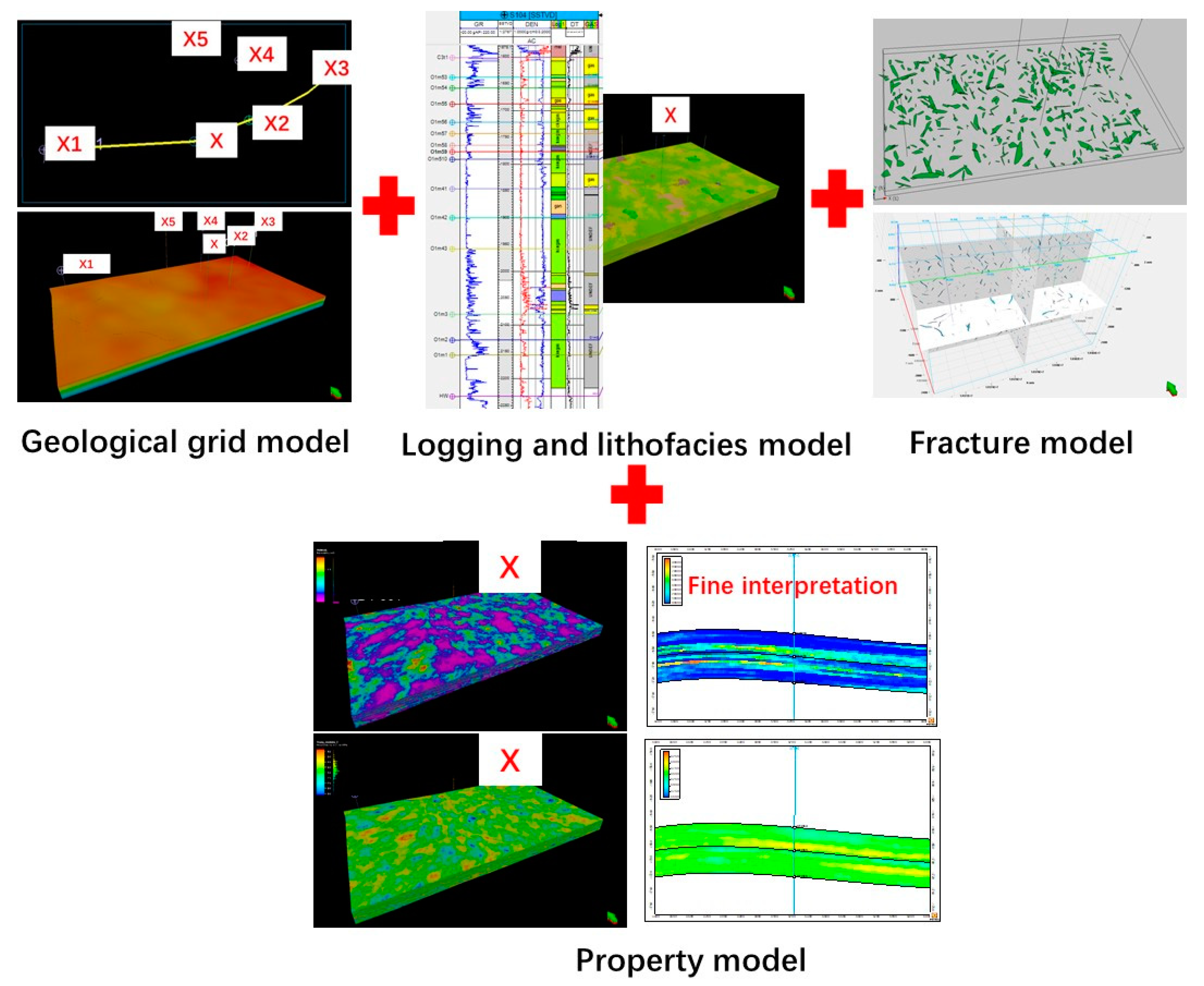

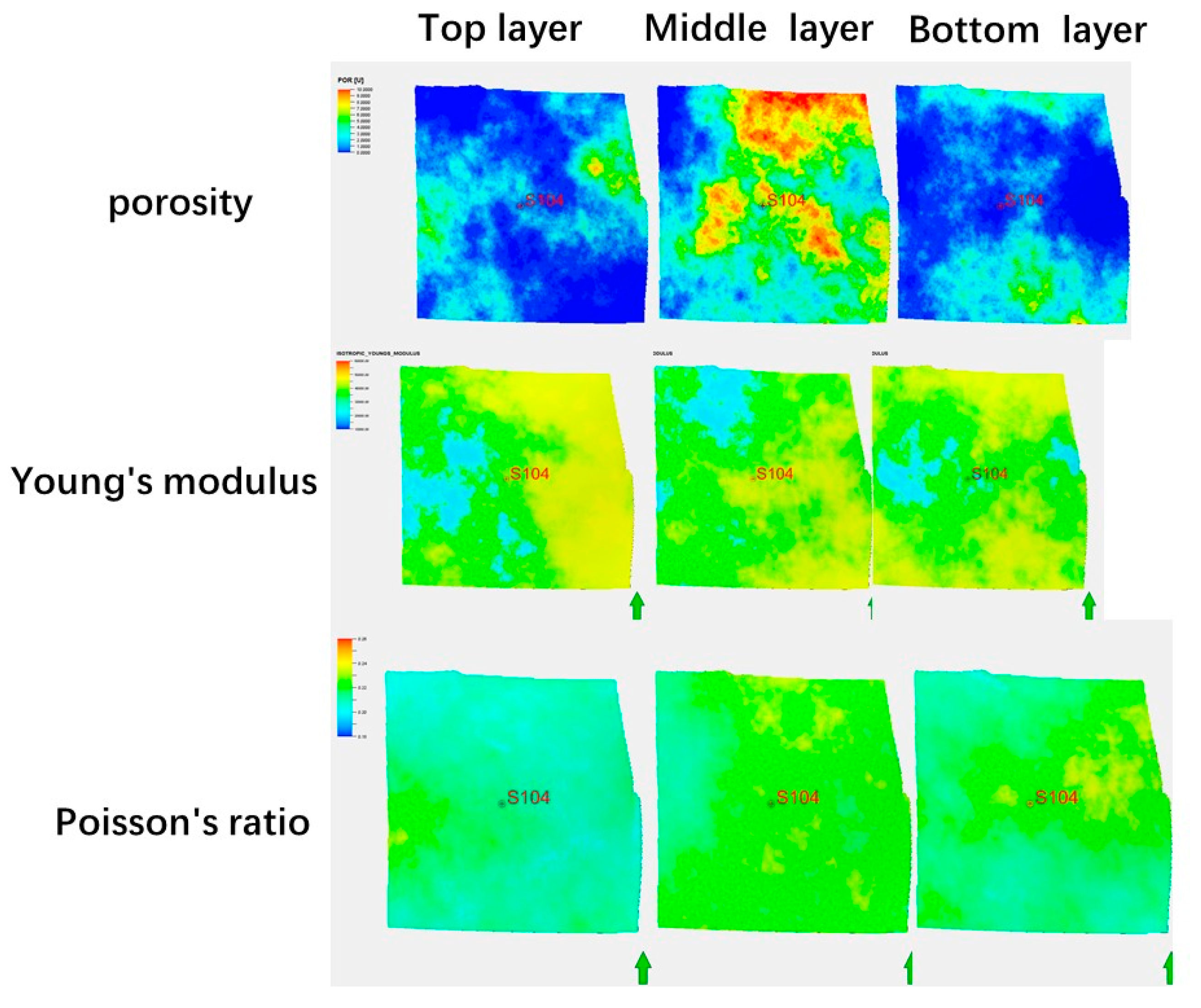
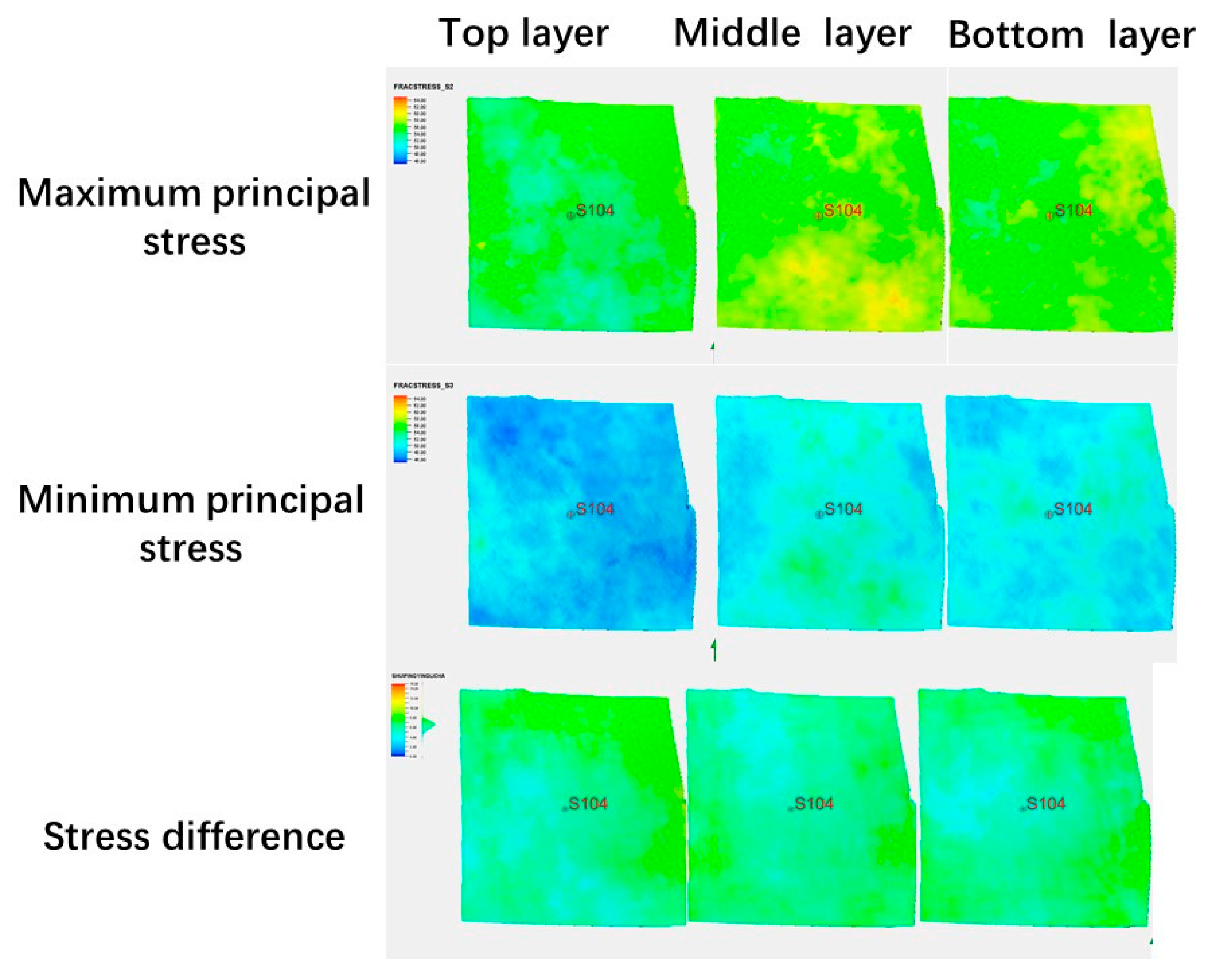
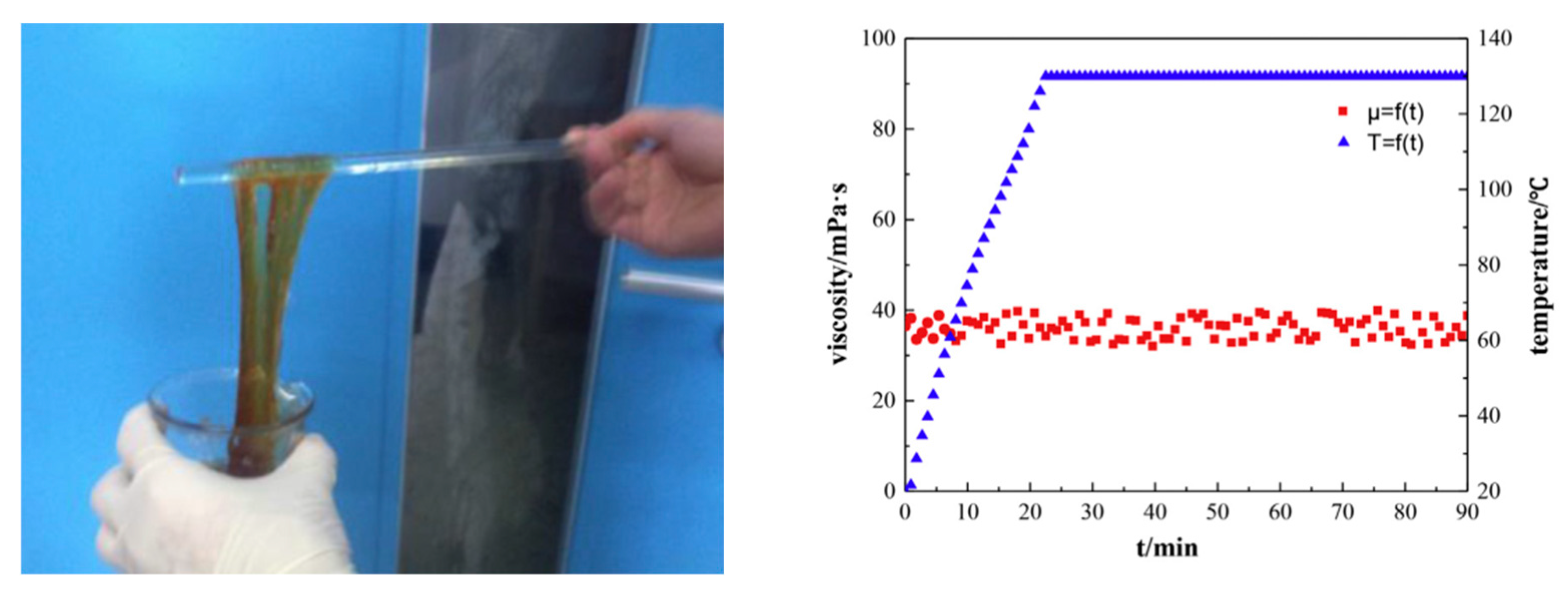
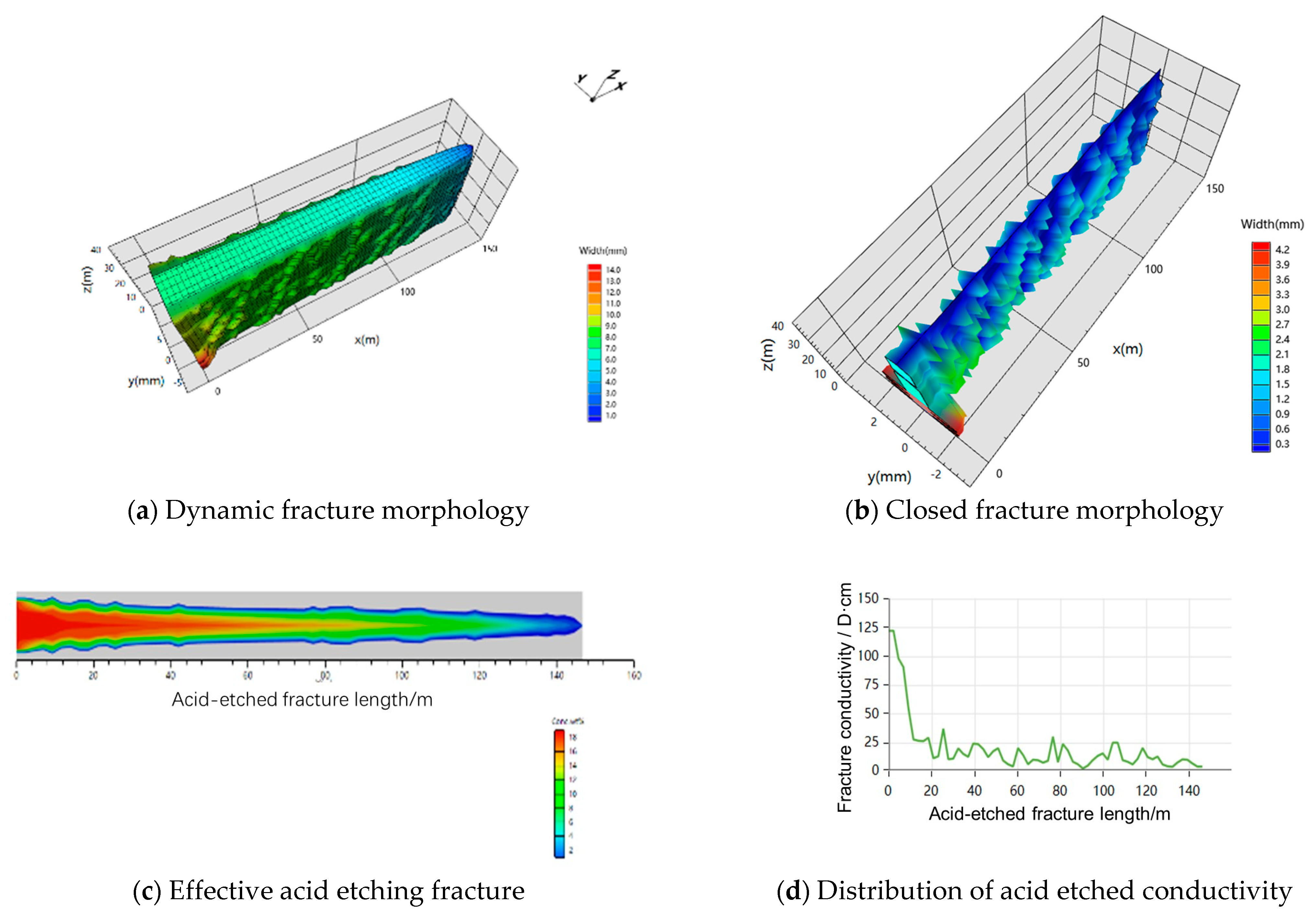
| Depth m | Carbonate Content % | Porosity % | Total Hydrocarbon Distribution % |
|---|---|---|---|
| 2973.0–2977.0 (Ma 5) | 44.7–76.0 | 5.3 | 5.02–13.99 |
| 2992.0–2995.5 (Ma 6) | 82.1–94.0 | 5.7 | 51.01–72.61 |
| Measure Depth m | GR API | RD Ω·m | AC μs/m | CNL % | DEN g/cm3 | VSH % | PER mD | Sg % | Conclusion |
|---|---|---|---|---|---|---|---|---|---|
| 2973.0–2977.0 (Ma 5) | 23.0 | 971.1 | 206.1 | 4.2 | 2.54 | 4.3 | 0.11 | 65.1 | Gas layer |
| 2992.0–2995.5 (Ma 6) | 42.6 | 1067.4 | 171.6 | 2.4 | 2.66 | 7.7 | 0.10 | 57.2 | Gas-bearing layer |
| Mineral | Content Range % | Average % | |
|---|---|---|---|
| Silicate | Quartz | 0.62~86.84 | 7.86 |
| Potassium feldspar | 0.00~15.77 | 1.04 | |
| Plagioclase | 0.00~52.46 | 1.96 | |
| Carbonate | Calcite | 0.27~95.17 | 33.65 |
| Dolomite | 0.00~86.29 | 33.63 | |
| Ferro-dolomite | 0.00~4.86 | 1.02 | |
| Clay | Illite | 0.05~13.97 | 3.40 |
| Illite mixed layers | 0.00~31.47 | 4.86 | |
| Calcareous clay | 0.00~6.34 | 1.58 | |
| Perforated Section m | Perforation Density hole/m | Perforation Angle ° | Perforation Diameter mm | Perforation Depth mm |
|---|---|---|---|---|
| 2973.0–2977.0 | 16 | 90 | ≥12 | ≥1000 |
| No. | Fluid | Injection Rate m3/min | Volume m3 | Note |
|---|---|---|---|---|
| 1 | Slick water | 1–2 | 50 | Establish displacement and cooling |
| 2 | Drag-reducing acid | 6–8 | 150 | Connect natural fractures |
| 3 | Gelled acid | 6–8 | 250 | Create fractures and etching |
| 4 | Slick water | 6–8 | 50 | Replace |
Disclaimer/Publisher’s Note: The statements, opinions and data contained in all publications are solely those of the individual author(s) and contributor(s) and not of MDPI and/or the editor(s). MDPI and/or the editor(s) disclaim responsibility for any injury to people or property resulting from any ideas, methods, instructions or products referred to in the content. |
© 2023 by the authors. Licensee MDPI, Basel, Switzerland. This article is an open access article distributed under the terms and conditions of the Creative Commons Attribution (CC BY) license (https://creativecommons.org/licenses/by/4.0/).
Share and Cite
Wang, X.; He, J.; Qiu, X.; Li, L.; Zhang, L. An Improved Acid Fracturing Design through RoqSCAN Technology: A Case Study from Daniudi Gas Field in Ordos Basin, China. Processes 2023, 11, 1475. https://doi.org/10.3390/pr11051475
Wang X, He J, Qiu X, Li L, Zhang L. An Improved Acid Fracturing Design through RoqSCAN Technology: A Case Study from Daniudi Gas Field in Ordos Basin, China. Processes. 2023; 11(5):1475. https://doi.org/10.3390/pr11051475
Chicago/Turabian StyleWang, Xiang, Jiayuan He, Xiaoqing Qiu, Lei Li, and Lufeng Zhang. 2023. "An Improved Acid Fracturing Design through RoqSCAN Technology: A Case Study from Daniudi Gas Field in Ordos Basin, China" Processes 11, no. 5: 1475. https://doi.org/10.3390/pr11051475




